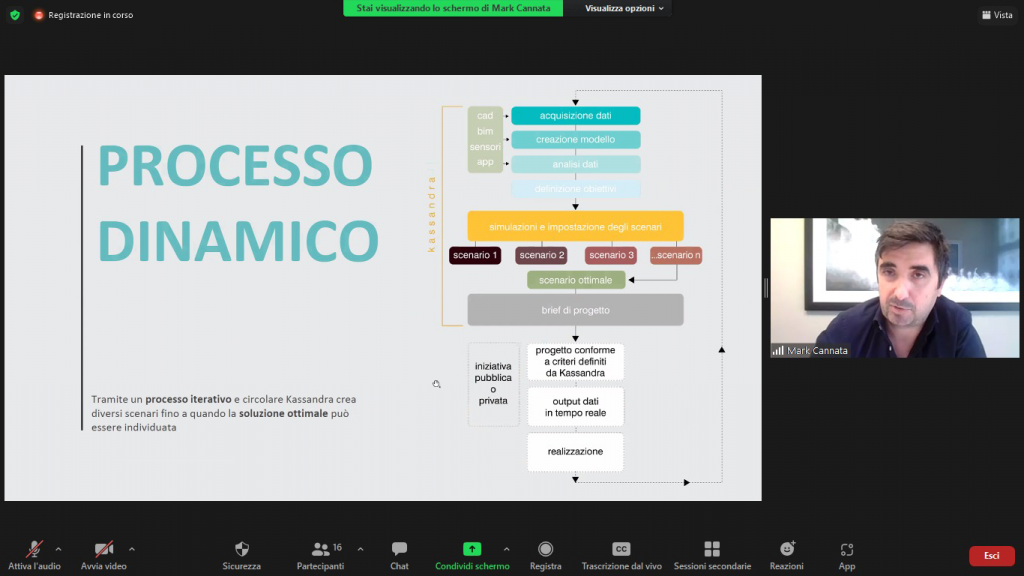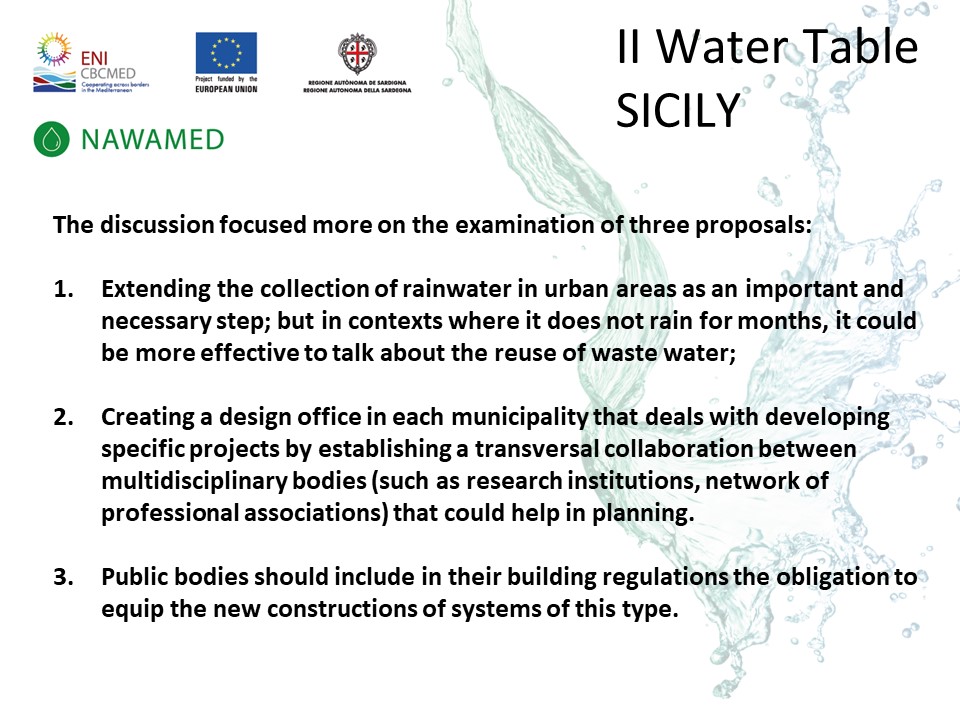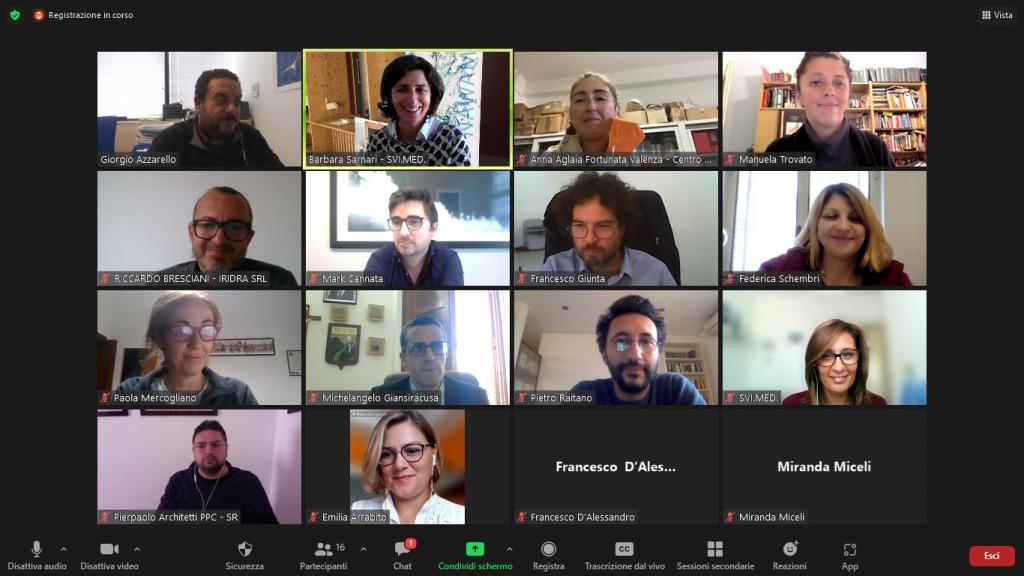NAWAMED second Water Table in Sicily: “Complex does not necessarily mean complicated”

“Existing and innovative technologies for the use of non-conventional water”: with this title the second of the four technical meetings, called Water Table, of the ENI CBC MED project NAWAMED was held on 21 October. It has been dedicated to the technologies in the field of domestic water reuse, and carried out in synergy with the Municipality of Ferla, associate partner, and the Network of Technical Professions Syracuse.
The Water Tables are consultation tools whose aim is to draw up strategic documents where possible integrative lines to local regulations and standards are indicated, in order to foster the use of non-conventional water resources in an urban context
At the beginning, Francesco Giunta - Network of Technical Professions Syracuse recalled the conclusions achieved during the First Water Table, where stakeholders debated about the possible barriers (technical, cultural, regulatory policies) that limit the use of non-conventional water resources (NCWR).

The work started with the intervention of Paola Mercogliano, senior researcher with more than 16 years of research experience at Euro-Mediterranean Centre for Climate Change CMCC, where she works as head of the REMHI division (Regional Model and geo-Hydrological Impacts). Mercogliano's speech, dedicated to climate change and water in the context of Italian cities, recalled that the issue is very complex, and that mitigation of the climate crisis must necessarily be accompanied by adaptation and reduction of its effects.
What is important to say is that there are no one-size-fits-all solutions: each context requires different interventions. Adaptation must be planned with local actors, not just the scientific community
Regarding the water cycle, Mercogliano stressed that today we are witnessing important changes in the hydrological cycle, which translate into significant impacts in terms of agricultural yields, social conflicts, energy demand, and resource quality.

Mark Cannata is founder and CEO of Kassandra srl, a support system for decision-makers. It is based on fundamental parameters that are all brought together under a single measurement tool. Kassandra gives an initial assessment of the study area, determines a resilience index and through the creation of scenarios predicts what the possible ‘futures’ might be, depending on the choices that are made. In short, a management system for public administrations.
Basically, we create a virtual twin of the urban environment and give resilience values for every possible initiative, such as planting a tree: water saving, the effect on temperatures….

Every Italian produces an average of 150/200 litres of grey water per day, of which about 100/140 can potentially be recovered; grey water, unlike rainwater, is present and therefore recoverable every day, easily perishable and immediately available. With these premises, Riccardo Bresciani of IRIDRA srl (NAWAMED's technical partner) illustrated a series of solutions to treat and reuse greywater at domestic level.
Among the solutions shown were compact, efficient and automatic technological solutions, thus the green walls envisaged in the NAWAMED project.
There are still significant costs for initial installations, further than high energy consumption and the need for specialised technical assistance for the compact systems, and a certain regulatory backlog and still few installations of green walls for treating and reusing greywater
These issues actually emerged in the ensuing debate, which involved the participants at the table.
B. Sarnari, moderator of the meeting, following the presentations stimulated the debate by offering some food for thought to the participants in relation to their role or profession.
The participants thus expressed the different opinions on existing and innovative technologies for the use of NCWR - greywater and rainwater - at the domestic level, focusing on future generations and planning in its broadest sense.
According to Giorgio Azzarello from Sicilian Region, the solutions presented as pilot actions can demonstrate the impact of these innovative measures for the reuse of water resources, and will be useful when the legislative body has to advance and legislate also on these issues.
The idea of education obviously also evokes the projection towards the new generations, as Francesco D'Alessandro and Federica Schembri recalled, reflecting on the pilot project planned in the Ferla school (a green wall to treat and reuse greywater), considering how it should be extended to many more institutions.
In addition to the solutions proposed by the speakers, the architect Anna Aglaia Fortunata suggested the recovery of ancient practices of harvesting and reuse rainwater, even if R. Bresciani stressed that these are not always "sufficient" especially in the summer and even this type of measures should therefore be planned on the basis of a detailed estimate of past, present and future scenarios (as presented by P. Mercogliano).

At the end of the debate, a vision hovered among those present at the working table suggested by M. Cannata:
Cities are complex systems to manage, but complex does not necessarily mean complicated
With this spirit we should avoid thinking that for a supra-territorial problem we must wait for planning from above, but also stimulate the territories, municipalities and technicians to take action to support planning and the adoption of innovative solutions, while encouraging the central government to adopt more forward-looking measures on the issue.
The next Water Tables will focus on "Assessment of environmental and socio-economic feasibility", thus the cycle of water table will be closed involving stakeholders in order to identify tools and strategies to foster NCWR at regional level.










